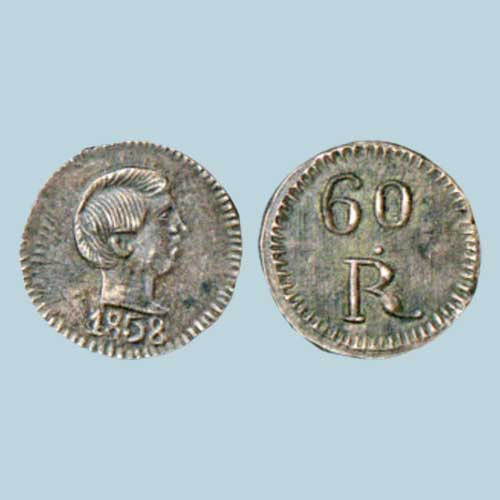Silver 60 Ries of Portuguese India
2017-08-16 Wed
The Portuguese Viceroyalty of India later known as the Portuguese State of India was the aggregate of Portugal's colonial holding in India. The Portuguese government started in India around 1505 - approximately six years after the visit of Vasco Da Gama. The "State of India" included all Portuguese possessions in the Indian Ocean.They minted coins in Daman but their capital was Goa. The Daman or Damao mint continued to function till 1854. The above shown silver coin was minted around 1858. The obverse of this coin depicts the bust of King Pedro V facing right and year ‘1858' within the toothed rim. The reverse of the coin depicts the value of the coin '60.R' within the toothed rim.
After India's independence from the British in 1947, Portugal refused to accede to India's request to relinquish control of its Indian possessions. The organisation of the United Front of Goans' took control of Dadra in 1954 and territory of Dadra and Nagara Haveli was seized later in 1954.
But later on the peaceful oppose of Satyagarhis to liberate Goa was suppressed brutally by the Portuguese government. On 18 December 1961, Indian military invaded Goa, Daman, and Diu under the command of Major General Kenneth P. Candeth. This annexation of Goa by the Indian Military also called as “Operation Vijay” or Portuguese-Indian War, involved air, water and land strikes over 36 hours.
The Governor of Portuguese India signed the Instrument of Surrender on 19 December 1961, ending 451 years of Portuguese rule in India.
To know more about Indo-Portuguese coinage click here.
Latest News
-
Gold Pagoda of Mysore King Hyder Ali
2024-05-10 FriHyder Ali ruled the Kingdom of Mysore in southern India from 1761 until he died in 1782. He began hi...
-
Gold Mohur of Muhammad Akbar Minted in Jaunpur
2024-05-09 ThuJaunpur, located in the Indian state of Uttar Pradesh, was once governed by the Sharqi dynasty.<br><...
-
Vijaynagar Emperor Krishnadevaraya's Gold Pratap Half-Hon Sold For INR 232000
2024-05-08 WedVijayanagar, a powerful kingdom in South India, was founded by two brothers, Harihara and Bukka, on ...
-
Muhammad Akbar Silver Rupee, minted in Lahore
2024-05-07 TueLahore, now in Pakistan, was a prosperous city in Punjab during the reign of Akbar. At that time, it...
-
Malwa Sultan Nasir Shah Gold Square Tanka
2024-05-06 MonNasir Shah ruled the Malwa Sultanate from AH 906 to AH 916. <br><br> Nasir Shah issued coins in g...

